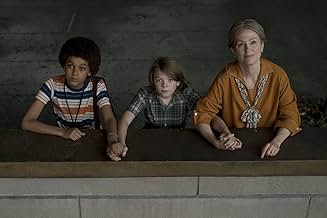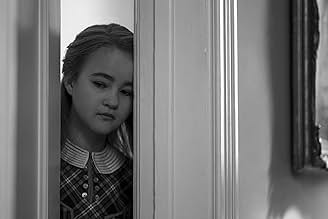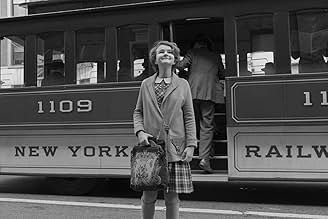CALIFICACIÓN DE IMDb
6.2/10
11 k
TU CALIFICACIÓN
Cuenta la historia de dos niños separados por cincuenta años. En 1927, Rose busca una actriz de cuya vida hace una crónica en su álbum de recortes; en 1977, Ben huye de casa para encontrar a... Leer todoCuenta la historia de dos niños separados por cincuenta años. En 1927, Rose busca una actriz de cuya vida hace una crónica en su álbum de recortes; en 1977, Ben huye de casa para encontrar a su padre.Cuenta la historia de dos niños separados por cincuenta años. En 1927, Rose busca una actriz de cuya vida hace una crónica en su álbum de recortes; en 1977, Ben huye de casa para encontrar a su padre.
- Premios
- 1 premio ganado y 35 nominaciones en total
Resumen
Reviewers say 'Wonderstruck' is a visually and emotionally rich film exploring childhood, loss, and identity through dual narratives set in 1927 and 1977. The artistic direction, contrasting black and white with color, and the performances, especially Millicent Simmonds, are praised. Music and sound design enhance the atmosphere. However, some find the pacing slow and plot convoluted, making it a divisive yet beautifully crafted film.
Opiniones destacadas
Carol was one of the best films I saw in 2015, as a matter of fact its probably the best film of that year. Everything about that film was so right. I really like Todd Haynes. Safe is also a fantastic film. I did like Far From Heaven and I'm Not There, though I'm not as crazy about those two. I saw the trailer for Wonderstruck and thought it looked interesting and could possibly be an experience like Carol or Safe. Wonderstruck is definitely a good film but its one of Todd Haynes' weaker efforts. That's really no knock on the film or the filmmaker, its just that Haynes' has set his own bar high.
The film portrays events in the lives of two children, one in the late 1927, the other in 1977. Both kids are deaf and have common elements in their life. Rose (1927) is running away from her dad to New York to find her idol, an actress in New York. Ben (1977) is recently orphaned and runs away to New York on a quest to find his estranged father. Both stories are intertwined and interwoven despite the already visible similarities from each tale. Its an interesting concept and Haynes utilizes unique filming styles to convey the tale, however the film doesn't always have high points and is a bit predictable.
The 1927 portion of the film emulates silent films of the era and is a tribute to movies of the time. The film is score heavy in this decade which makes the picture seem authentic. The score for this film is rather excellent and could be up for award contention at year's end. The 1977 portion has that gritty and colored frame that perfectly represents the cinematography of films of that era. I applaud Haynes for his presentation in style. The child actors do quite well. I actually didn't even realize Michelle Williams was in the film. Its a warm and fuzzy film that lacks any real conflict which I think was needed to perfect the film. Its a very saccharine effort which will appease younger viewers and Haynes definitely intended for it to be that way.
I have to go back to the score because its really riveting. Adds to the magic and wonder of the film and the experiences of the two leads. I love seeing New York in film throughout different decades so visually this film offers a definite viewing experience. Wonderstruck is not Haynes' best effort but like most of his other films its an ambitious effort and technically outstanding.
7/10
The film portrays events in the lives of two children, one in the late 1927, the other in 1977. Both kids are deaf and have common elements in their life. Rose (1927) is running away from her dad to New York to find her idol, an actress in New York. Ben (1977) is recently orphaned and runs away to New York on a quest to find his estranged father. Both stories are intertwined and interwoven despite the already visible similarities from each tale. Its an interesting concept and Haynes utilizes unique filming styles to convey the tale, however the film doesn't always have high points and is a bit predictable.
The 1927 portion of the film emulates silent films of the era and is a tribute to movies of the time. The film is score heavy in this decade which makes the picture seem authentic. The score for this film is rather excellent and could be up for award contention at year's end. The 1977 portion has that gritty and colored frame that perfectly represents the cinematography of films of that era. I applaud Haynes for his presentation in style. The child actors do quite well. I actually didn't even realize Michelle Williams was in the film. Its a warm and fuzzy film that lacks any real conflict which I think was needed to perfect the film. Its a very saccharine effort which will appease younger viewers and Haynes definitely intended for it to be that way.
I have to go back to the score because its really riveting. Adds to the magic and wonder of the film and the experiences of the two leads. I love seeing New York in film throughout different decades so visually this film offers a definite viewing experience. Wonderstruck is not Haynes' best effort but like most of his other films its an ambitious effort and technically outstanding.
7/10
Greetings again from the darkness. If you know an adolescent who is ready to step up from comic book movies, this would be a terrific introduction to more emotionally dramatic and narrative-driven cinema. That's certainly not meant to imply that director Todd Haynes' latest is only for kids, or even that it's aimed at that demographic. Instead, it's the rare opportunity to follow two intersecting story lines over two different time periods with kids as the main focus, and have some very interesting post-movie discussions related to characters, eras, and filmmaking techniques.
We follow the stories of two kids who are separated by 50 years. Although the time boundary exists, the similarities between their journeys are many. Each is running away from home in search of their roots and identity. They are both hearing-impaired and living in less than ideal family environments. Additionally, their footsteps cross many of the same places in New York City as two museums play key roles.
Ben (Oakes Fegley, PETE'S DRAGON) is a 12 year old living in Gunflint, Minnesota. It's 1977 when his mother (Michelle Williams) dies unexpectedly and a freak accident takes his hearing. Convinced an odd bookmark is a clue to finding the father he's never met, Ben sets off for New York City. Rose (remarkable first time actress Millicent Simmonds) lives in 1927 Hoboken, New Jersey and is obsessed with silent screen star Lillian Mayhew (Julianne Moore in a dual role). Rose is an artistic child whose domineering dad has little time for her, so she hops aboard the ferry and heads to the big city to track down an idol - who may be more closely tied than we first imagine.
Brian Selznick adapted the screenplay from his own novel (he also wrote "The Invention of Hugo Cabret", which was the basis for Scorcese's HUGO), and some may find the two story lines muddled or difficult to follow. However, for those who connect with the characters and their adventures, it's a fascinating and entertaining ride. Director Todd Haynes (FAR FROM HEAVEN, CAROL) has established his expertise in visual stylings, and here he gets to present two distinct looks for the separate eras. Ben's 1977 world is filled with the polyester and neon colors of that era and it's even given the washed-out look of 1970's cinema. On the opposite end of the spectrum, Rose's 1927 world is presented in black and white as a silent movie. The lack of dialogue allows us to focus on her facial expressions and body language, which tell us what we need to know.
The American Museum of Natural History plays a significant role in both stories, and the Queens Museum is central to the finale which ties up the two pieces for us. The contrasts of the two eras are as vital as the similarities. Along the way, each of the kids gets a bit of help. Ben befriends Jamie (Jaden Michael) whose connection to the museum and the city provides Ben a boost, while Rose's much older brother Walter (Cory Michael Smith) also has a connection to the museum and helps put Rose on the right track. The distinct photographic styles help us easily switch between eras, and much credit goes to cinematographer (and frequent Haynes collaborator) Edward Lachman and editor Affonso Goncalves.
Oscar Wilde's quote, "We are all in the gutter but some of us are looking at the stars", takes its shot as the theme for the two stories, and really it's a heartfelt film with interesting storytelling and unusual cinematic effects. The set design is terrific throughout, and especially vital during the silent movie segments of Rose's story. Carter Burwell's prominent score also effectively shifts styles between stories and eras. The ties that bind us – a core need to understand our roots – do so regardless of age and time period. This is a nifty little film that provides much to discuss and consider.
We follow the stories of two kids who are separated by 50 years. Although the time boundary exists, the similarities between their journeys are many. Each is running away from home in search of their roots and identity. They are both hearing-impaired and living in less than ideal family environments. Additionally, their footsteps cross many of the same places in New York City as two museums play key roles.
Ben (Oakes Fegley, PETE'S DRAGON) is a 12 year old living in Gunflint, Minnesota. It's 1977 when his mother (Michelle Williams) dies unexpectedly and a freak accident takes his hearing. Convinced an odd bookmark is a clue to finding the father he's never met, Ben sets off for New York City. Rose (remarkable first time actress Millicent Simmonds) lives in 1927 Hoboken, New Jersey and is obsessed with silent screen star Lillian Mayhew (Julianne Moore in a dual role). Rose is an artistic child whose domineering dad has little time for her, so she hops aboard the ferry and heads to the big city to track down an idol - who may be more closely tied than we first imagine.
Brian Selznick adapted the screenplay from his own novel (he also wrote "The Invention of Hugo Cabret", which was the basis for Scorcese's HUGO), and some may find the two story lines muddled or difficult to follow. However, for those who connect with the characters and their adventures, it's a fascinating and entertaining ride. Director Todd Haynes (FAR FROM HEAVEN, CAROL) has established his expertise in visual stylings, and here he gets to present two distinct looks for the separate eras. Ben's 1977 world is filled with the polyester and neon colors of that era and it's even given the washed-out look of 1970's cinema. On the opposite end of the spectrum, Rose's 1927 world is presented in black and white as a silent movie. The lack of dialogue allows us to focus on her facial expressions and body language, which tell us what we need to know.
The American Museum of Natural History plays a significant role in both stories, and the Queens Museum is central to the finale which ties up the two pieces for us. The contrasts of the two eras are as vital as the similarities. Along the way, each of the kids gets a bit of help. Ben befriends Jamie (Jaden Michael) whose connection to the museum and the city provides Ben a boost, while Rose's much older brother Walter (Cory Michael Smith) also has a connection to the museum and helps put Rose on the right track. The distinct photographic styles help us easily switch between eras, and much credit goes to cinematographer (and frequent Haynes collaborator) Edward Lachman and editor Affonso Goncalves.
Oscar Wilde's quote, "We are all in the gutter but some of us are looking at the stars", takes its shot as the theme for the two stories, and really it's a heartfelt film with interesting storytelling and unusual cinematic effects. The set design is terrific throughout, and especially vital during the silent movie segments of Rose's story. Carter Burwell's prominent score also effectively shifts styles between stories and eras. The ties that bind us – a core need to understand our roots – do so regardless of age and time period. This is a nifty little film that provides much to discuss and consider.
10asrashid
I absolutely love this movie. David Ehrlich wrote:"This is a soul-stirring and fiercely uncynical film that suggests the entire world is a living museum for the people we've lost, and that we should all hope to leave some of ourselves behind in its infinite cabinet of wonders". I couldn't have said it better myself. Of course it is a bit slow and maybe too complicated for a kid (it's definitely not for everyone). But A LOT of people actually love The Greatest Showman or another rubbish...I am 25 years old - I watched it with my mother who is 60 years old and we enjoed it. The ending is quite outstanding in my opinion. Everyone involved did such a beautiful job.
This was almost exactly what I expected based on the average reviews. Definitely a significant downgrade from Carol. I appreciated its ambition and some of its visuals, cinematography, and music is really good. But that screenplay is kind of a huge mess, and such a big missed opportunity. I don't see why this film would get much dislike, but I also don't see why it would get much love either. It's almost the complete opposite of mother!, which is probably the worst spot to be in. As soon as it was over I had forgotten it and felt so much apathy towards it. Not terrible or even bad, but not all that good either.
How is a Todd Haynes film with a character based on Lillian Gish this bad? And why is this his follow-up to Carol?!
This YA mystery – adapted by its author – has an intriguing dual- time structure, a nice Carter Burwell score and some neat nods to silents, but it's also cloying, not very mysterious, and incredibly longwinded: not trusting its audience to understand anything, and struggling with some laborious translation problems reminiscent of Le mèpris, in which a lot of the dialogue has to be written down and held up. It doesn't help that the central kid seems to have wandered in from a school play. Or that it ends up looking like an extended advertorial for some museums.
It's sort of like Hugo, if everything that Scorsese's film had done had gone a bit wrong.
(The Gish films being homaged, incidentally, are primarily The Wind (the poster of the film-within-a-film starring 'Lillian Mayhew' is based directly on a publicity image for this 1928 masterpiece) and Orphans of the Storm, though she played mothers in few of her starring vehicles and Wonderstruck diverts considerably from her real life.)
This YA mystery – adapted by its author – has an intriguing dual- time structure, a nice Carter Burwell score and some neat nods to silents, but it's also cloying, not very mysterious, and incredibly longwinded: not trusting its audience to understand anything, and struggling with some laborious translation problems reminiscent of Le mèpris, in which a lot of the dialogue has to be written down and held up. It doesn't help that the central kid seems to have wandered in from a school play. Or that it ends up looking like an extended advertorial for some museums.
It's sort of like Hugo, if everything that Scorsese's film had done had gone a bit wrong.
(The Gish films being homaged, incidentally, are primarily The Wind (the poster of the film-within-a-film starring 'Lillian Mayhew' is based directly on a publicity image for this 1928 masterpiece) and Orphans of the Storm, though she played mothers in few of her starring vehicles and Wonderstruck diverts considerably from her real life.)
¿Sabías que…?
- TriviaIn the book, the story of Rose is told alternatively without text but with graphics to allow the readers to experience Rose's story in the same way she felt escaping to New York City through her eyes and the silence of her life.
- ErroresWhen Ben enters the rotunda of the American Museum of Natural History, he walks past the mounted skeletons of the Allosaurus attacking a Barosaurus defending its young, as seen in the museum today. However, this exhibit was not mounted until 1991, and wouldn't have been seen in 1977.
- ConexionesFeatured in WatchMojo: Top 10 Failed Oscar Bait Movies of 2017 (2018)
Selecciones populares
Inicia sesión para calificar y agrega a la lista de videos para obtener recomendaciones personalizadas
- How long is Wonderstruck?Con tecnología de Alexa
Detalles
- Fecha de lanzamiento
- País de origen
- Sitios oficiales
- Idiomas
- También se conoce como
- Wonderstruck
- Locaciones de filmación
- Productoras
- Ver más créditos de la compañía en IMDbPro
Taquilla
- Total en EE. UU. y Canadá
- USD 1,060,377
- Fin de semana de estreno en EE. UU. y Canadá
- USD 65,882
- 22 oct 2017
- Total a nivel mundial
- USD 3,285,916
- Tiempo de ejecución
- 1h 56min(116 min)
- Color
- Mezcla de sonido
- Relación de aspecto
- 2.35 : 1
Contribuir a esta página
Sugiere una edición o agrega el contenido que falta









































